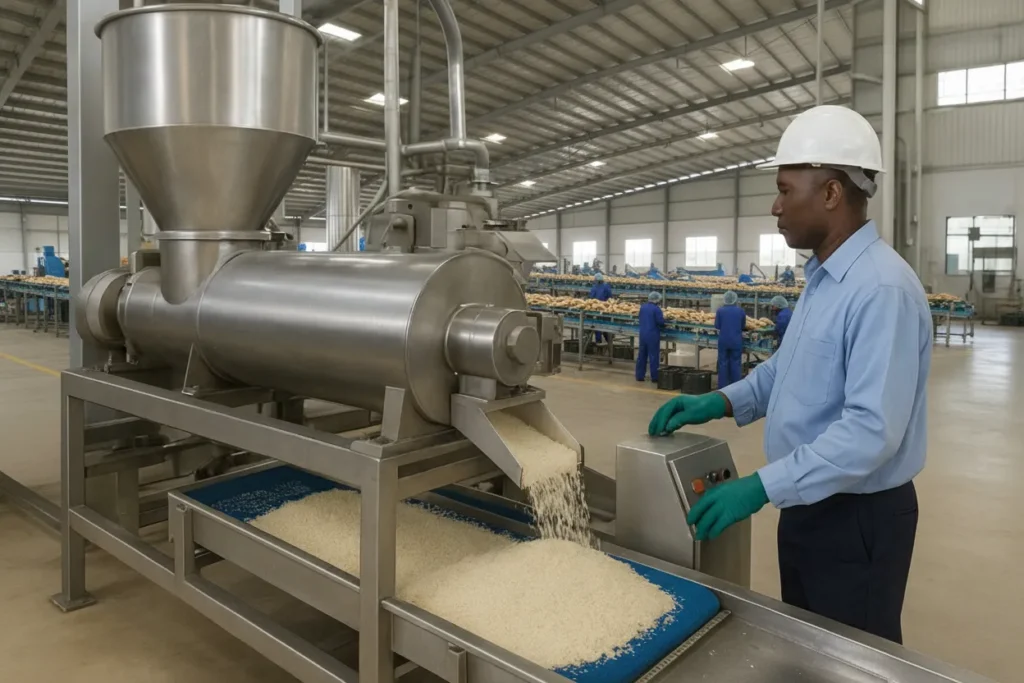1. Why Cassava Processing Is a Billion-Naira Opportunity
Nigeria’s cassava sector has moved far beyond garri and fufu. With over 60 million tons produced yearly, cassava now fuels multiple industries — food, pharmaceuticals, ethanol, animal feed, and even adhesives.
The global shift toward import substitution and agro-industrialization means investors who move beyond raw cassava farming into value addition can see margins 2–5× higher.
This guide explores 10 high-demand cassava products that guarantee long-term profitability and export potential.
2. Garri — Still the People’s Favourite
Why it works: Garri remains Nigeria’s top cassava derivative, consumed daily by millions.
Processing Steps: Peeling → Grating → Fermenting → Frying → Sieving.
Startup cost: ₦500,000 – ₦3 million (depending on scale).
Profit range: ₦700,000 – ₦2 million/month for mid-level processors.
Market: Retail, wholesalers, export (diaspora demand).
3. High-Quality Cassava Flour (HQCF)
Why it works: HQCF is used in baking, noodles, and adhesives.
Processing Steps: Peeling → Drying → Milling → Packaging.
Key buyers: Flour Mills of Nigeria, Dangote, pasta producers.
Profit driver: 40% cheaper than wheat flour — ideal for blending.
Export potential: High (West Africa + UK).
4. Cassava Starch
Why it works: Used in textiles, paper, and pharmaceuticals.
Processing Steps: Crushing → Screening → Sedimentation → Drying.
Equipment cost: ₦5–₦10 million for industrial-grade setup.
Market size: ₦100 billion+ annually in Nigeria.
Profit driver: Long shelf life, consistent industrial demand.
5. Fufu Flour
Why it works: Urban consumers prefer ready-to-eat, odorless alternatives to wet fufu.
Processing Steps: Fermentation → Dehydration → Milling.
Target market: Supermarkets, export buyers, eCommerce.
Profit driver: Strong export niche (UK, US, Canada).
6. Animal Feed Pellets
Why it works: Cassava peels and by-products are ideal for low-cost feed.
Processing Steps: Drying → Grinding → Pelletizing.
Equipment: Small feed mill (₦2–₦5 million).
Market: Poultry, fish, piggery, and ruminant farmers.
Profit driver: Converts waste into revenue.
7. Cassava Chips
Why it works: Dried chips are used for ethanol and starch production.
Processing Steps: Slicing → Drying → Packaging.
Market: China, Europe, and ethanol plants in Nigeria.
Profit driver: Easy to produce, low spoilage, export-friendly.
8. Ethanol (Industrial Alcohol)
Why it works: Used in pharmaceuticals, cosmetics, and beverages.
Processing Steps: Fermentation → Distillation → Dehydration.
Setup cost: ₦20–₦40 million (industrial scale).
Profit driver: Growing ethanol blending demand under Nigeria’s biofuel policy.
Market: High-value B2B, consistent contracts.
9. Cassava Starch Adhesives
Why it works: Used in packaging, paper, and labeling industries.
Processing Steps: Blending cassava starch with borax and caustic soda.
Target market: Paper mills, packaging companies.
Profit driver: Substitute for synthetic adhesives.
10. Cassava-Based Snacks
Why it works: Innovative cassava snacks (chips, crackers, biscuits) are popular in urban markets.
Processing Steps: Slicing → Frying/Baking → Seasoning → Packaging.
Market: Schools, supermarkets, export.
Profit driver: Fast-moving, brandable consumer product.
11. How to Choose the Right Product for Your Business
| Business Size | Recommended Product | Investment Range |
|---|---|---|
| Small Scale (₦500k – ₦2m) | Garri, Fufu flour, Chips | Low entry, fast ROI |
| Medium Scale (₦3m – ₦10m) | HQCF, Animal Feed, Snacks | Steady B2C/B2B markets |
| Large Scale (₦15m – ₦50m) | Starch, Ethanol, Adhesives | Industrial & export markets |
Pro Tip: Focus on one or two products first, build process efficiency, then expand into complementary lines.
12. Marketing and Export Channels
- Local retail distribution – supermarkets, agro shops, wholesalers.
- Partnerships with industries – bakeries, feed producers, ethanol plants.
- Export via NEPC – register under Non-Oil Export Scheme.
- Online presence – list on Alibaba, Trade Depot, and NigeriaAgroExport.com.
- Branding & packaging – clean, shelf-ready packaging boosts retail appeal.
13. Investment Insight: The Numbers Behind Cassava Value Chains
According to the Federal Ministry of Agriculture (FMARD), the cassava processing industry is valued at over ₦3 trillion annually.
By 2030, the demand for industrial starch and HQCF is expected to outstrip supply by 40%.
That means local processors who build capacity now stand to dominate regional markets.
14. Funding Opportunities
CBN’s Agricultural Credit Scheme – for agro-processing ventures.
- BOI Agro Cluster Fund – machinery & factory support.
- NEPC Export Development Grant – for verified exporters.
- Private impact investors – interested in sustainable food processing.
15. Final Thoughts
Cassava is Nigeria’s quiet powerhouse. From garri to ethanol, every root harvested carries multiple income streams.
Whether you’re an entrepreneur, investor, or cooperative, processing cassava into high-demand products is one of the smartest agribusiness moves in 2025.
Thinking of starting your cassava processing venture? Partner with Tanus Agro for reliable sourcing, market access, and investor-backed opportunities. Get in touch with us




